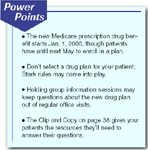Article
Medicare's drug coverage: Get ready for questions
By educating yourself, you can help answer your patients' questions—and there are bound to be lots of them.
If you think you and your patients had trouble understanding Medicare coverage before, it's going to get a little more complicated in the coming months, when the prescription drug benefit (often referred to as Part D) is introduced. No one says you have to be an expert on the new program, but it would help to know a few basics, since patients are bound to come to you with their questions.
Beneficiaries will have a choice of at least two prescription drug plans, and possibly many more depending on where they live. Those who currently have prescription drug coverage through a Medicare Advantage plan or other Medicare health plan will get a notice from the plan about their choices. If a patient doesn't have prescription drug coverage and wants to add it, he can:
Patients who are dually eligible for both Medicare and Medicaid will be automatically enrolled in a plan at the end of 2005 if they haven't chosen one.

Thankfully, there's some protection against your patient making a "wrong" choice, as all of the plans must provide a Medicare-set standard level of coverage. And, of course, patients have the option to sign up with a different plan during their next open enrollment.
The enrollment timetable is fast approaching
On Jan. 1, the new Medicare prescription drug plans (PDPs) will be available to anyone who has Medicare Part A or Part B. Those who want it-and want coverage to begin on Jan. 1-will have to enroll between Nov. 15 and Dec. 31. For the first year of the program, patients can enroll until May 15, 2006. Thereafter, decisions on enrolling or changing plans will generally have to wait until the next November-December enrollment period.
One thing worth reminding patients about: those who don't enroll when they're first eligible may have to pay a penalty if they decide to join later on, unless they have coverage that's at least as good as standard Medicare prescription drug coverage (such as from a former employer or union). The Medicare participant will receive a notice from the entity providing the coverage, telling him if the plan he's got will provide as much or more than a Medicare prescription drug plan.
It's also important to note that the Medicare prescription drug benefit, which will be managed by private companies in conjunction with Medicare, is a separate program from the one that introduced Medicare-approved drug discount cards in June 2004. Patients who have drug discount cards may use them until May 15, 2006-or until they begin receiving coverage under a Medicare prescription drug plan, whichever is earlier.





